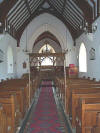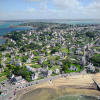


































|
|




The photograph above left
is St Caranog Church, Llangrannog, Centre photograph is the Mosaic on the
Sea Front, with St Caranog shown on the left. Photograph on the right is a
Stained Glass window in the church.
Click on the Photographs to
see Full size

The Story of Saint Carannog

The Celtic saint
Caranog
was also known as
Carantus, Cranog and Carantacus. His
father was Corun, the son of the
great Ceredig, from whom we have
the name for this county CEREDIGION..
Corun ruled over South Wales, which
then incorporated parts of South West England. He was anxious that Caranog succeeded him to the throne,
but Caranog
refused and became a missioner. These early Saints did most of their
travelling by sea, following the coast and never went far inland.
It is known that Caranog
flourished in these parts somewhere from 480 A.D. 540 A.D. - his influence
covers a wide area because there are churches dedicated to his name in
several areas...
Crantock
in Cornwall...
Carhampton
in
Somerset...
Carantec in
North West Brittany...

 St Carannog Family History
St Carannog Family History

Saint Caranog is discussed in
pages. 226-236
The Uses of Secular Rulers and
Characters in the Welsh Saints

Photograph of
Carantec
Click on picture to see Full Size

Dulane
near Kells in Ireland...
Many miraculous deeds are
attributed to St. Caranog and it is said that pilgrims came from far and
wide to drink of the waters of St Mary's fountain in the parish: there is a
house opposite the top end of the churchyard which is known as" Ffynon Fair"
_"St. Mary's Well or Fountain".
(The Well has been badly overgrown for years, however we hope that with a
change of ownership, it will be cleared and the public will have access)
An interesting legend links St. Caranog
with King Arthur....
St. Caranog
and St.
Patrick were said to be
great friends and ministered together. In Ireland he was given another name
-- Ceirnach, the name he kept till his
death....
Most of the information above
is taken from Mervyn Davies's book "The Story of Llangrannog". published in
the 1970's. An updated version of this book has now been published and is
available by mail order or from the local shops. See
NEW BOOK for details.
Other references to St
Carantoc can be found in Canon G H Doble's "Cornish Saints" series, which is
in six parts. References to St Carantoc are contained in Part 4 - Newquay,
Padstow and Bodmin district.
|
Extract from Saints of
May 16
6th century. A Welsh abbot, founder of the church
of Llangrannog, Wales, Carantock visited Ireland and on his return founded a
monastery at Cernach of which he was abbot. (He is associated with Crantock
in Cornwall and Carhampton in Somerset.) He is also said to have visited
Brittany, where he is highly venerated, but to have returned to Cernach
where he died. Some writers identify him with Saint Carantac (f.d. today)
(Benedictines, Delaney).
|
| |
|
Extract
from Celtic and Old English Saints 16 May
=-=-=-=-=-=-=-=-=-=-=-=-=-=-=-=-=-=-=-=-=
* St. Carantoc
* St. Carantock Carhampton
=-=-=-=-=-=-=-=-=-=-=-=-=-=-=-=-=-=-=-=-=
St. Carantoc, Abbot
---------------------------
(also known as Carantog, Cairnach, Carnath)
5th century. A Welsh prince who laboured under Saint Patrick in the
evangelization of Ireland (Benedictines).
St. Carantock of Carhampton, Abbot and Founder of Llangranog, Wales
(Carannog, Carantocus, Carentoc), Abbot
--------------------------------------------------------------
6th century. A Welsh abbot, founder of the
church of Llangranog,
Cardiganshire, Wales, Carantock visited Ireland as a missionary and on
his return founded a monastery at Cernach of which he was abbot. He led
a group of monks who evangelized central Cornwall, and is said to have
migrated from there to Brittany, where he is highly venerated as Saint
Caredec. Before the end of his life he returned to Cernach, where he
died. William Worcestre mentions a 'Sanctus
Cradokus' (which may mean Cadoc or Carantock) in a church or chapel near
Padstow, where he was venerated because of 'his destroying worms when
people drink the water of a well there.' He is patron of Crantock in
Cornwall, Llangranog, and Carhampton in Somerset. Roscarrock mentions a
Cornish church dedicated to Carantock, which had seven churchyards
attached to it. Parishioners from these seven churches came annually to
bring relics to the mother church and place them on special stones like
altars. Some writers identify him with Saint Carantac (f.d. today).
The feast of Saint Carantock is celebrated in South Wales, Somerset,
Cornwall, and Brittany (Attwater2, Benedictines, Coulson, Delaney,
Farmer).
Another Life of Saint Carantock
Saint Carantoc was the son of Ceredig, King of Cardigan, but he chose
the life of a hermit and lived in a cave above the harbour of the place
now called after him, Llangranog, where there is also a holy well, which
he probably used. When the people tried to force him to succeed his
father, he fled, and founded a religious settlement in Somerset at
Carhampton. According to legend, his portable altar was lost as he
crossed the Severn Sea and was washed up at the mouth of the little
brook Willet near Carhampton. Carantoc went to King Arthur, the leader
of the British resistance to the Saxon invaders, to ask his help to
recover his altar, and the King asked him in return to tame a dragon
that was troubling the neighbourhood.
According to the legend, after Carantoc had prayed to the Lord, the
dragon came running to the man of God and humbly bent his head to allow
him to put his stole around his neck and to lead him like a lamb,
lifting neither wing nor claw against him. After a time the dragon was
released and departed having been instructed not to molest the human
inhabitants of the land again. This is said to have taken place at
Dunster.
Besides Carhampton, Carantoc founded a religious settlement at Crantock
across the river Gannel from Newquay, and then, according to Capgrave,
was led by his guardian angel to journey to Ireland to assist St.Patrick
in the conversion of that island. In Ireland he cured one of his
disciples, Tenenan, of his leprosy by giving him a hot bath. His
ministry did not end in Ireland for he is honoured in Brittany as the
founder saint of Carantec and the neighbouring parish of Tegarantec,
which was probably originally Tref Carantoc.
St.Carantoc died in the middle of the sixth century, and Bath Abbey,
which held the living of Carhampton, kept his festival on May 16th. The
Welsh, Cornish, Irish and Breton calendars commemorate him at this time
(Bowen, Baring Gould and Fisher, Farmer, John).
Troparion of St Carantoc tone 7
Preferring to serve in the Kingdom of God/ than to rule an earthly
kingdom, 0 Father Carantoc,/ thou didst convert many to Christ in
Ireland, in thy native Wales and in Cornwall,/ where having cast out the
dragon and founded many churches/ thou wast a shining beacon guiding
many souls/ into the Way of Salvation./ Pray now to Christ our God that
He will save our souls.
|
|


